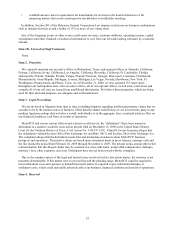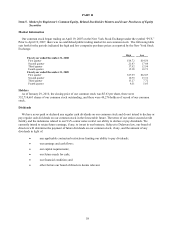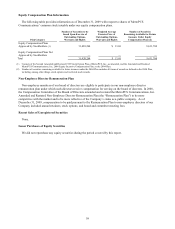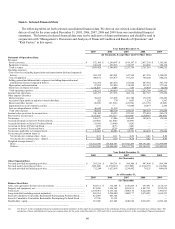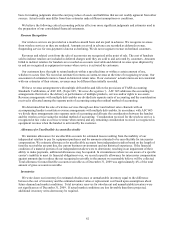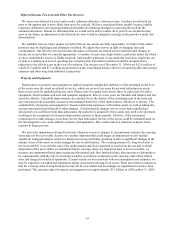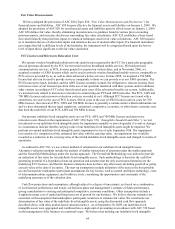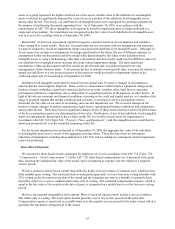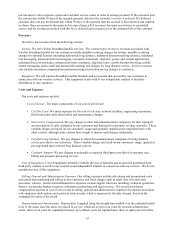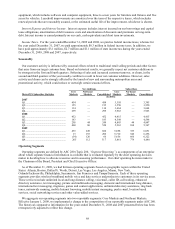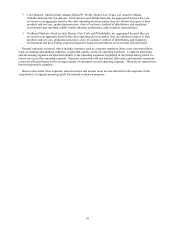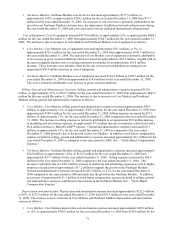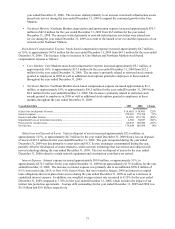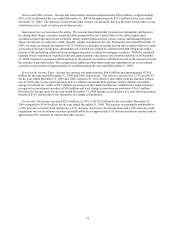Metro PCS 2009 Annual Report Download - page 77
Download and view the complete annual report
Please find page 77 of the 2009 Metro PCS annual report below. You can navigate through the pages in the report by either clicking on the pages listed below, or by using the keyword search tool below to find specific information within the annual report.65
assets as a group represents the highest and best use of the assets, and the value of the indefinite-lived intangible
assets would not be significantly impacted by a sale of one or a portion of the indefinite-lived intangible assets,
among other factors. Previously, our indefinite-lived intangible assets were segregated by operating segments for
the purpose of performing the annual impairment test. As of September 30, 2009, in accordance with the
requirements in ASC 350, these intangibles were separately tested for impairment prior to being combined as a
single unit of accounting. No impairment was recognized as the fair value of each indefinite-lived intangible asset
was in excess of its carrying value as of September 30, 2009.
Historically, we have not experienced significant negative variations between our assumptions and estimates
when compared to actual results. However, if actual results are not consistent with our assumptions and estimates,
we may be required to record an impairment charge associated with indefinite-lived intangible assets. Although we
do not expect our estimates or assumptions to change significantly in the future, the use of different estimates or
assumptions within our discounted cash flow model when determining the fair value of our indefinite-lived
intangible assets or using a methodology other than a discounted cash flow model could result in different values for
our indefinite-lived intangible assets and may affect any related impairment charge. The most significant
assumptions within our discounted cash flow model are the discount rate, our projected growth rate and
management’s future business plans. A one percent decline in annual revenue growth rates, a one percent decline in
annual net cash flows or a one percent increase in discount rate would not result in impairment related to the
combined single unit of accounting as of September 30, 2009.
Indefinite-lived intangible assets must be tested between annual tests if events or changes in circumstances
indicate that the asset might be impaired. These events or circumstances could include a significant change in the
business climate, including a significant sustained decline in an entity’s market value, legal factors, operating
performance indicators, competition, sale or disposition of a significant portion of the business, or other factors. In
light of the adverse economic and financial conditions occurring in the credit and capital markets, we considered the
range of potential impacts that market conditions and economic events had on our key assumptions used to
determine the fair value of our units of accounting since our last impairment test. We reviewed changes in the
business climate, changes in market capitalization, legal factors, operating performance indicators and competition,
among other factors. There have been no significant changes in any of these factors that have adversely affected any
of the key assumptions used in our determination of fair value. Furthermore, if any of our indefinite-lived intangible
assets are subsequently determined to have a finite useful life, we would test such assets for impairment in
accordance with ASC 360 (Topic 360, “Property, Plant, and Equipment”), and the intangible assets would then be
amortized prospectively over the estimated remaining useful life.
For the license impairment test performed as of September 30, 2009, the aggregate fair value of the indefinite-
lived intangible assets was in excess of the aggregate carrying values. There also have been no subsequent
indicators of impairment, including those indicated in ASC 360, and accordingly no subsequent interim impairment
tests were performed.
Share-Based Payments
We account for share-based awards exchanged for employee services in accordance with ASC 718 (Topic 718,
“Compensation – Stock Compensation”). Under ASC 718, share-based compensation cost is measured at the grant
date, based on the estimated fair value of the award, and is recognized as expense over the employee’s requisite
service period.
We have granted restricted stock awards that entitle the holder to receive shares of common stock which become
fully tradable upon vesting. The restricted stock awards granted generally vest on a four-year vesting schedule with
25% vesting on the first anniversary date of the award and the remainder pro-rata on a monthly or quarterly basis
thereafter, subject to a service condition that relates only to vesting. The estimated compensation expense, which is
equal to the fair value of the awards on the date of grant, is recognized on a ratable basis over the four-year vesting
period.
We have also granted nonqualified stock options. Most of our stock option awards include a service condition
that relates only to vesting. The stock option awards generally vest in one to four years from the grant date.
Compensation expense is amortized on a ratable basis over the requisite service period for the entire award, which is
generally the maximum vesting period of the award.




